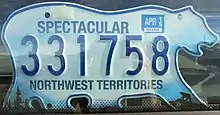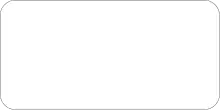Vehicle registration plates of the Northwest Territories
The Canadian territory of Northwest Territories first required its residents to register their motor vehicles and display licence plates in 1941. Only rear plates have been required since 1986.
 | |
| Current series | |
|---|---|
| Slogan | Spectacular Northwest Territories |
| Material | Aluminum |
| Serial format | 123456 |
| Introduced | July 1, 2010 |
| Availability | |
| Issued by | Driver and Vehicle Offices, Department of Infrastructure |
| History | |
| First issued | 1941 |
In 1970, to celebrate the centennial of the territory, a unique polar bear-shaped plate was introduced. The basic bear shape has been retained ever since, and the plate is now a registered trademark of the Government of the Northwest Territories.[1]
The current design, which consists of graphic and material updates, was rolled out on July 1, 2010. The blue-and-white plates prior to the update were made of steel and lack graphic sheeting technology that would make them visible in the dark. Current plates are made with aluminum and incorporated visual updates as well as a new slogan.[2]
Influence on Nunavut plate design
In April 1999, the territory of Nunavut was created from the eastern part of the Northwest Territories. The new territory adopted a virtually identical bear-shaped licence plate, following an agreement between the governments of the two territories. In 2011, the Government of Nunavut decided to discontinue the bear shape and replace it with a conventional rectangular design, which was introduced in July 2012.
Passenger plates 1947 to present
In 1956, Canada, the United States and Mexico came to an agreement with the American Association of Motor Vehicle Administrators, the Automobile Manufacturers Association and the National Safety Council that standardized the size for licence plates for vehicles (except those for motorcycles) at 6 inches (15 cm) in height by 12 inches (30 cm) in width, with standardized mounting holes.[3] The first Northwest Territories licence plate that complied with these standards was issued five years beforehand, in 1951. The current bear-shaped plates feature the standard mounting holes.
| Image | First issued | Design | Slogan | Serial format | Serials issued | Notes |
|---|---|---|---|---|---|---|
 |
1947 | Black on silver | none | 123 | 1 to approximately 400 | |
 |
1948 | White on blue | none | 123 | 1 to approximately 600 | |
 |
1949 | White on green | none | 123 | 1 to approximately 500 | |
 |
1950 | Black on orange | none | 1234 | 651 to approximately 1350 | |
 |
1951 | Orange on black | none | 1234 | 1351 to approximately 2100 | First 6" x 12" plate. |
 |
1952 | White on blue | none | 123 | 100 to approximately 650 | |
 |
1953 | Black on orange | none | 123 | 100 to approximately 800 | |
 |
1954 | Orange on black | Canada's Northland | 123 | 100 to approximately 900 | |
 |
1955 | Black on orange | Canada's Northland | 123 | 100 to approximately 900 | |
 |
1956 | Orange on black | Canada's Northland | 1234 | 100 to approximately 1100 | |
 |
1957 | Black on orange | Canada's Northland | 1234 | 100 to approximately 1400 | |
 |
1958 | Orange on black | Canada's Northland | 1234 | 100 to approximately 2200 | |
 |
1959 | Black on orange | Canada's Northland | 1234 | 100 to approximately 2300 | |
 |
1960 | Orange on black | Canada's Northland | 1234 | 100 to approximately 2400 | |
 |
1961 | Black on orange | Canada's Northland | 1234 | 100 to approximately 3100 | |
 |
1962 | Orange on black | Canada's Northland | 1234 | 100 to approximately 4000 | |
 |
1963 | Black on orange | Canada's Northland | 1234 | 100 to approximately 3900 | |
 |
1964 | Orange on black | Canada's Northland | 1234 | 100 to approximately 4200 | |
 |
1965 | White on light green | Canada's Northland | 1-234 | 100 to approximately 4-900 | |
 |
1966 | Black on reflective orange; territorial shield at left | Canada's Northland | 12-345 | 100 to approximately 11-500 | Revalidated for 1967 with white-on-blue tabs, for 1968 with red-on-white tabs, and for 1969 with green-on-white tabs. |
 |
1970 | Bear-shaped; white on blue | Centennial | 1-234 | 1 to approximately 7-500 | First bear-shaped plate. Awarded inaugural "Plate of the Year" for best new licence plate of 1970 by the Automobile License Plate Collectors Association. |
 |
1971 | Bear-shaped; blue on white | none | 1-234 | 1 to approximately 8-500 | |
 |
1972 | Bear-shaped; white on blue | none | 12-345 | 1 to approximately 10-500 | |
 |
1973 | Bear-shaped; dark blue on white with yellow slogan, date, and border | RCMP Centennial | 12-345 | 1 to approximately 11-000 | |
 |
1974 | Bear-shaped; red on white | none | 12-345 | 1 to approximately 11-500 | |
 |
1975 | Bear-shaped; turquoise on white | none | 12-345 | 1 to approximately 18-000 | Revalidated for 1976 with stickers. |
 |
1977 | Bear-shaped; red on white | none | 12-345 | 1 to approximately 21-500 | Revalidated for 1978 with stickers. |
 |
1979 | Bear-shaped; turquoise on white | none | 12-345 | 1 to approximately 21-500 | Revalidated for 1980 with stickers. |
 |
1981 | Bear-shaped; red on white | none | 12-345 | 1 to approximately 21-000 | Revalidated for 1982 with stickers. |
 |
1983 | Bear-shaped; blue on white | none | 12-345 | 1 to approximately 30-500 | Last dated plate. Revalidated for 1984 and 1985 with stickers. |
 |
1986 | Bear-shaped; blue on white | Explore Canada's Arctic | 123456 | 1 to approximately 126000 | Monthly staggered registration introduced 1990. |
 |
2010 | Bear-shaped; nature scene | Spectacular | 123456 | 300000 to 355362 (as of September 15, 2019) |
Non-passenger plates
| Image | Type | First issued | Design | Serial format | Serials issued | Notes |
|---|---|---|---|---|---|---|
 |
Commercial | 2010 | As Spectacular passenger base | C12345 | C30000 to present | |
 |
Trailer | 2010 | As Spectacular passenger base | T12345 | T40000 to present |
References
- "Nunavut polar bear (license plate) on verge of extinction". APTN. August 5, 2011. Retrieved October 18, 2011.
- "N.W.T. licence plates get update". CBC News. Retrieved 18 October 2020.
- Garrish, Christopher (October 2016). "Reconsidering the Standard Plate Size". Plates. Vol. 62 no. 5. Automobile License Plate Collectors Association.